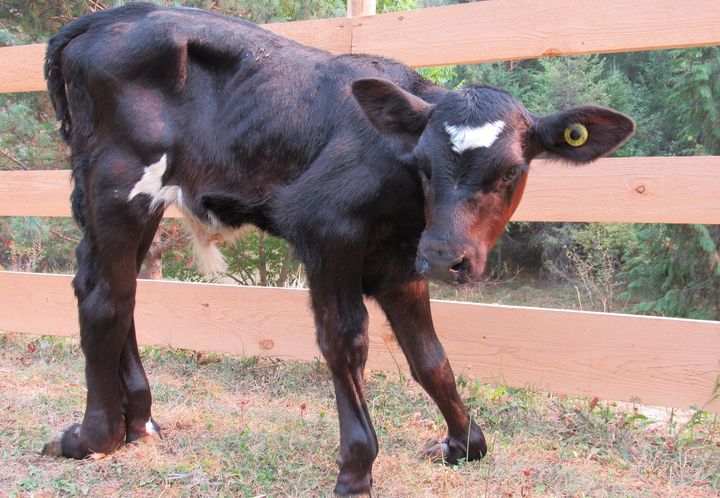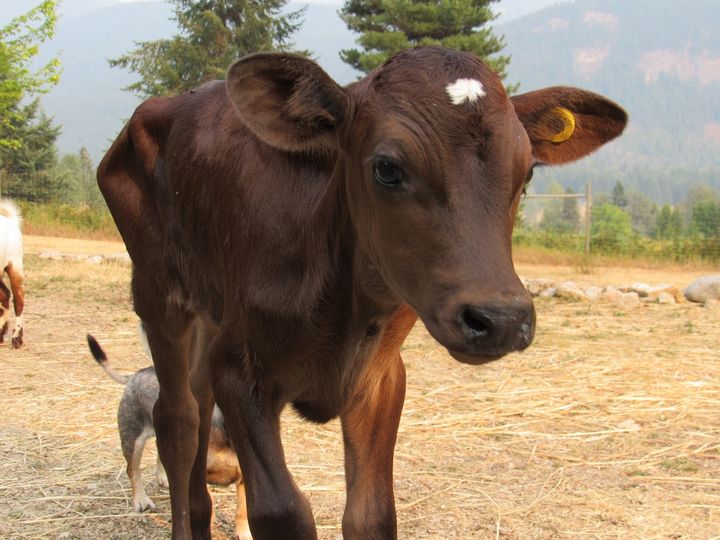When Patricia and Ernest Smuga got word from a friend that a nearby dairy farm had two male calves they planned to get rid of, the Smugas knew they’d give the calves a forever home at their family’s farm sanctuary. What they didn’t know was that they were signing up for months of wound care, vet visits, bills, and emotional healing—for them and for the calves.
On dairy farms—even organic and certified humane ones—cows are kept pregnant most of the time. Like all mammals, cows only produce milk after pregnancy, so they must continually give birth in order to maintain lactation. The babies they give birth to are literally a byproduct of this process. Although the female calves can eventually be used as dairy cows too, the males have no commercial purpose and are typically quickly sold for meat. Whether female or male, the calves are separated from their mothers shortly after birth to minimize bonding and so that the mothers’ milk can all be packaged for human consumption.
Patricia arranged with the farm to come pick up the calves. Even though she was familiar with how the dairy industry works and she’d researched the specific farm beforehand—seeing videos of people touring the farm, where the babies were openly kept apart from their mothers—she wasn’t prepared for what she’d see and feel when she arrived.
“The first thing I noticed was this heavy feeling in the air,” Patricia says, “like when you’re having a nightmare that you’re trying to wake yourself up from but just can’t. There was a stall in the very front where there was a newborn calf, just a few hours old, sitting in the hay next to his mother, who eyed us warily. The baby was so vulnerable, eyes barely adjusted to the light of his new world, looking at him mom as if seeking safety and comfort. I had to put my sunglasses to hide my tears, knowing this helpless baby was destined to be taken from his mother the next day to fend for himself and eventually be killed.”
The farmer led Patricia to a dirty corner, where the calf they’d call Jimmy was laying. His leg was deformed with a deep open wound. Patricia, who holds a medical degree, asked the farmer what was wrong with him and what kind of treatment he’d need; the farmer said he had no idea. Jimmy had received neither veterinary care nor appropriate medication. The other calf who came home with them, Julian, was five days old and malnourished.

Jimmy’s leg wounds prevented him from walking normally. After months of care, he’s now almost healed.
For the next four months, Patricia and Ernest did daily wound care on Jimmy, spending hours some days to splint his leg, dress the wound, and treat the inflammation. He was seen by three vets and given surgery to fuse a joint in his lower leg. Jimmy’s leg is still in a cast, but the initial wound is finally healed and he has been responding well to physiotherapy. Julian was diagnosed with two parasitic infections and required weeks of antibiotics.

The Smugas bottle-fed Jimmy and Julian three times a day with warmed milk. On dairy farms calves are often given low-grade formula in buckets. In a natural setting, calves would nurse from their mothers for at least their first six months of life.
Despite his injuries and the deprivation of his mother, Jimmy has always been like a giant puppy, Patricia says. He nuzzles his head into people’s laps for rubs and scratches, loves the attention of the Smuga’s three children, and manages to run around almost like a normal calf. Julian, on the other hand, is still learning to trust humans. He spent his first days mooing sadly and, Patricia believes, looking around for his mother.

Julian is still learning to trust humans.
Jimmy and Julian have been inseparable from the beginning. They play together, lick and nudge each other, and keep each other company. Even when Jimmy had to be isolated following his surgery, Julian sat outside his stall and nuzzled him through the door.
Despite what happened to Jimmy and Julian, Patricia says the farmer wasn’t mean, “but his eyes were dull and I'm sure his heart was calloused.” Patricia believes the issue isn’t with this one particular dairy farm—which is considered a local gem in her region, a model of sustainable and humane agriculture—but rather with the industry as a whole. She wants people to understand that dairy farming could never be humane because it requires cows to be constantly impregnated, babies and mothers to be separated, and ultimately for all of them to be killed when their lives are no longer profitable.
Jimmy and Julian continue to heal and thrive under the constant, loving care of their adoptive family. Through their example, the Smugas are showing that these calves have lives worth living, that they are more than simply trash.
To donate to the ongoing costs of their care, please visit here.
